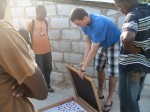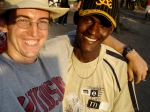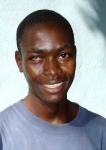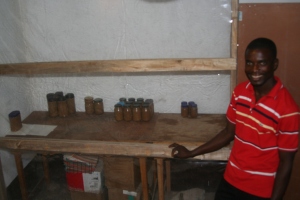I’m three trips overdue on blog updates. Over Spring Break I was able to join a Medical Student Missions team in Verrettes. I was back in Bayonnais in late May with a group from IOH Methodist Church before returning to the US for my 5-year Davidson College reunion. My most recent trip was split between Bayonnais and the Haiti Foundation of Hope in Terre Blanche.
Leading mission teams in Bayonnais is always a rich but demanding experience. By now, most of my Haitian friends understand I have little time to sit down and catch up when teams are present. This is why I felt strongly about returning to Bayonnais on my own to invest time in various friendships.
TOUGH LOVE, PB v. R&B, AND COLD TAMPICO
Charles Etienne is one such friend; in fact, he is my godbrother. His wife died in October, 2010 when cholera first struck Bayonnais, and a precarious financial situation continues to mire his attempts to provide food for his three children. In a mud-hut room, adjacent to where I watched my godson open his eyes for the first time 3 years earlier, I sat amid extended family and listened. . . It turns out Mme Etienne hadn’t had cholera after all; she had been sick with an undiagnosed illness that had been coming and going for years. As Etienne described desperately driving her to the hospital on his motorcycle, only to have her fall off 5 minutes down the road, I heard his mother quietly start to cry from the darkness in the corner of the room. Barely strong enough to stand, he had carried her lifeless body half a mile to his in-laws house where the official grieving process began.
In the light of a small kerosene lamp, Etienne continued to share the hardships of this past year. Help from extended family allowed him to pay off the remaining loans he had taken out for his wife’s funeral. In Haiti, regardless of how destitute you may be, if a loved one dies, he/she will be buried in a coffin. Culturally, it is extremely disrespectful to put someone in the ground without one, and great loans and sacrifices will be made in order to afford the at least $500US necessary to make the purchase. (Consider the national pain associated with the post-quake mass burial outside Port-au-Prince.) A request for the wedding ring in order to help pay funeral expenses was denied by his in-laws, and great drama ensued when he took the children back to his house; he thought his family could take better care of them, and he didn’t want them to grow up not knowing their father. However, his brother-in-law, who had been borrowing his moto-taxi, trashed it while his mother-in-law deceitfully acquired money from Etienne’s pig sale. His impression is that they want to see him fall on his face. (Of course, this is one side of a two-sided story.) Worst of all, his mother-in-law blamed him for his wife’s death, painful words he will never forget and unlikely forgive.
Based on 3 months of Etienne recording dollars spent and earned for his moto-taxi business, we learned that if there is a lot of traffic and he works every day, he can expect to make about $100 US / month. (This assumes he wasn’t fudging numbers in his bookkeeping. Basic financial analysis like this is foreign to the vast majority of people in Bayonnais; “small business” owners know they’ll make a profit if they sell a given good marked up from their purchase price, but no one keeps track of the Gourdes, and everyone sells on credit. However, there’s a new generation of educated youth with high school math sufficient for basic budgeting.) “Okay, you’ve got a hundred dollars this month. How are you going to spend it?” I asked him. His first priority, along with feeding his kids, seemed to be putting up a headstone on his wife’s grave, which would cost around $85 US. It is very difficult navigating the tension between encouraging dependence via financial aid and the necessary tough love that pushes him to make it happen on his own; it’s hard because when he doesn’t, those young children don’t eat during critical phases of their development. Before leaving Bayonnais, I was blessed to be able to cover the headstone (a specific, localized expense) allowing him to use income from a one-month day-labor job in the mountains to repair his motorcycle. (Note, he worked so hard, and with so little food, on this job that he’d have to stay up in the mountains for days at a time, as he was too weak to return home to see his family.)
During our conversation, I learned something very interesting about feeding his children: although it is roughly three times more expensive to provide rice and beans than an extra-think peanut butter sandwich, he would rather the kids eat rice and beans. Through further conversation with other friends, I learned that the three Artibonite staples, rice, corn, and millet, are so ingrained (pun intended) in the cultural mindset that Bayonnaisiens will forgo days of not eating in order to afford a “legitimate” meal. Peanut butter sandwiches are more than welcomed as a snack or lunch at school, but it is apparently embarrassing to eat peanut butter sandwiches as a main meal at home; it means you’re dirt poor. My gentle caution to Etienne was to be careful not to sacrifice his kids’ nutrition to his pride, as eating peanut butter sandwiches every day would be better for them than rice and beans 3 or 4 times per week. Understanding the depth of the cultural roots mentioned above, I simply hope peanut butter gets mixed into the family diet just a little more than it presently is.
Lastly, on returning home that night, I found myself drinking a cold Tampico (fruit juice) in front of the new refrigerator. Thinking of Etienne’s work under the hot sun and wondering about the last time he had enjoyed a cold beverage, I felt the subtle tug of the Holy Spirit, to which I replied in my head, “Am I really going to walk back to his place this late at night to give him this drink?” . . . While taking his first sip, I asked Etienne about the last time he’d had a cold drink. “I can’t remember. . . It’s been so long,” he said.
BAYONNAIS MEDICAL CLINIC, CHOLERA
Perhaps, though unlikely, it’s been as long as Bayonnais’ dream for a medical clinic. As many readers know, the comment that hit me hardest upon first meeting Actionnel (leader of OFCB) regarded healthcare. He said he wept when he learned that there are such things as veterinarians in the US, for there are no doctors for people in Bayonnais. I can testify to the consequences; I’ve heard of far too many deaths—people of all ages—during my time in Bayonnais. However, thanks to God, Engineers Without Borders, and many committed individuals, the dream is becoming a reality. Phase 1 of 3 is under construction this summer, and the coming years will bring 2 doctors, a dentist, and multiple nurses, all of whom went through the OFCB school before being sponsored for higher education.

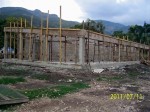

Anne-Junie, one of the nurses who has already finished her degree, has been working in the cholera clinic. Founded in October/November, 2010 when the outbreak began and still operational due to demand, this make-shift clinic has literally saved many hundreds of lives, probably a thousand. (Not all patients who arrive have cholera, and those that do have varying levels of severity.) Cholera patients tend to come in from the mountains, and sometimes cases are so severe that peripheral pulses are absent. Thanks to Anne-Junie and some of her classmates, many of these patients are doing well several IV bags later.



HAITI FOUNDATION OF HOPE
The following is a refection from my time with HFH, an organization located in Terre Blanche (near Gonaives) and very similar to OFCB.
“Love is what makes you smile when you’re tired,” says four-year-old, Terri, her response included in an article about children’s definitions of love. Her peer, Billy, affirms, “When somebody loves you, the way they say your name is different. You just know that your name is safe in their mouth.” As Dr. Dave’s gentle voice meets the foreign sounds of a pediatric patient’s name, I’m reminded of this safety. A rich smile seconds his tone. Blossoming on her mothers lap, little Ji-ji opens from a guarded position–at least enough for heart and lung sounds. Nurse Becca offers a pretty red ball to encourage further comfort, but then I hear my own name called. Dr. Richeme would like to teach me about cervical cancer; my name feels safe in his mouth.
Here at the Haiti Foundation for Hope, I feel like I’m part of a family. The solidarity espoused by Haitian and American leadership is remarkable. My first visit was in February of 2008: curious about what was going on in Terre Blanche, I had come to visit for two days but ended up staying a full week translating for a medical team. When it became possible to join another team this summer, I leaped at the opportunity. My first-year medical school training was itching for context and clinical application, and, boy, did I get my fair share! The experience deepened my sense of vocation and reminded me why I am privileged to be in medical school. It’s tiring, but hearing Ji-ji quietly tell mom, “li gou,” or “it tastes good,” while receiving a 5 mL/min oral rehydration treatment for cholera . . . well, it made me smile.
The Haiti Foundation for Hope quotes, “Lespwa fe viv,” a Haitian proverb that loosely translates, “Hope gives life.” In God’s economy, hope is a valuable currency. It appreciates much, and though easily shared it is not easily spent. I go to Terre Blanche to be and to hold God’s hands. I go to heal and be healed, to be reminded that beneath my seeming self-sufficiency, I guard spiritual vulnerabilities not unlike the physical hardships of my Haitian brothers and sisters. In Terre Blanche, peoples’ names sound different and safe because God, who is love, is at work. Truly I tell you, there is hope enough for us all.
To elaborate on getting “my fair share” of clinical application, I got to see mumps, scabies, cutaneous anthrax, hemorrhoids, inguinal hernias (help retract one), a hydrocele, HPV polyp removal, multiple abscesses, listen/feel a ventricular septal defect, palpate prostate and advanced cervical cancer, witness a birth, use the sonogram, and assist multiple surgeries, including ainhum amputation and a circumcision of a 20-something year old—ouch! Dr. Rolf Richeme, a Haitian doctor in general surgery residency, was one reason for such a rich experience; he was such a good teacher that he’d eventually leave the room after the surgery was over, telling me, “Alright, sow it up.” Then he’d come back and joke that the suturing took much longer than the surgery itself. (Below are photos of the cutaneous anthrax patient and the effects of antibiotic treatment; she gave permission to take and share these images. The last image shows me suturing after a lipoma resection.)


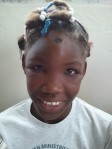
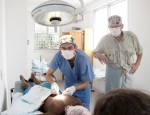
NEW SHOES
At one point I showed Dr. Richeme a picture of a someone in Bayonnais unlike anyone he’d seen during 10 years of general practice in Port-au-Prince. Also known as “lobster claw syndrome”, ectodactyly is a genetic defect characterized by developmental abnormalities in the hands and feet; fingers and toes are variably fused or absent. Several members of a family in Bayonnais have this syndrome, the youngest of which has only a pinky finger on each hand. They function relatively normally, for example one man is working on construction of the medical clinic. However, as you can imagine, it is difficult/nearly impossible to find shoes. My mom noticed this issue in May and returned to the US determined to address the need. Armed with traced outlines of feet, she entered Smart Feet in Savannah where the owner had “happened” to have been researching ectodactyly the previous couple weeks. She asked me whether they’d like the suggested shoes, as they were very clunky and not very attractive by US standards. “I think they’ll love them,” I said. “If not, I can always bring them back.” As you can see in the following photographs, they were well-received.
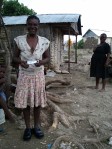
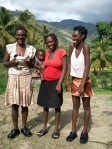
MICROENTERPRISE
Unfortunately, beautiful containers of Manba Bayonnais, or Bayonnais peanut butter, were not as well-received in the city of Gonaives. “Mami” and Mme Alez were the directors of the Bayonnais Peanut Butter Project, a small enterprise about which you can read more in previous posts, and part of this most recent trip involved getting a more of an update about what went wrong. Basically, it seems the missing puzzle piece was a skilled marketing agent.
Almost everything was good: they had a workplace equipped with an efficient, motorized grinder and understood extensive methods for selecting against aphlatoxin-contaminated nuts; the product was delicious, unique (they added cinnamon), and well-packaged; we had researched the peanut butter market in Gonaives as well as our competitor, which didn’t taste as good and with whose price we were confident we could compete; they had bank accounts, capital for starting the business, and a local consultant (Firmen); they had excitement about the prospect of running the first legitimate small business in Bayonnais; lastly, they had pride in their peanut butter. However, for some reason they hit a brick wall trying to sell to distributors in Gonaives. When I mentioned a recent contact, the female manager of the St. Marc Delimart (an upscale grocery), who was interested in seeing the product, Mme Alez was not interested. I could see that trying to sell peanut butter in Gonaives had been exhausting; in fact, she and “Mami” had already comfortably moved back to working in the kitchen at OFCB.
When I reflect upon the entirety of the Bayonnais Peanut Butter Project, from its initial conception as a subsidized protein source under the umbrella of OFCB to an independent, entrepreneurial venture owned by two women, the following comes to mind: listen very well, and hear from the right people–direct solicitation of Firmen’s honest feedback, which he didn’t readily offer, early on may have avoided some challenges during the first phase of the project. Lastly, it’s just hard to start a legitimate business in Bayonnais, but we’ll keep encouraging those who are interested.
On a more positive note, I ate some 14-month-old dehydrated bananas that tasted just as good as when they were desiccated in the solar dryer; I should also stress that they didn’t make me sick. These were part of a running fruit preservation experiment that had been going on for over a year in the closet of the back left bedroom. While dried bananas don’t have any Haitian market value at this time, it was pretty cool to eat one and see that solar dehydration works. (Bananas are available throughout the year, as opposed to sweet peppers, which are available only a couple months. Hopefully someone will run with the idea of selling dried fruits or veggies in the off-season; the sweet peppers dry very well.)
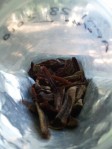
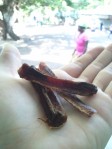
CHECK YOUR EGO
During the IOH Methodist devotional one evening, I decided to share an interesting encounter that caught me off-guard. Walking to and from the market, I’m engaged in many brief conversations about how and what I’m doing. Most people know me and call me by name, Pite (“Pee-tay”). However, one little kid called me “Blan,” the blanket term used for any foreigner, and I responded, “Mwen rele Pite,” or “My name is Peter.” Although quick and casual, the remark tasted of ego and the notion that this little kid should know my name. It’s a very strange experience to be in a place where you’re so conspicuous, where so many people know and appreciate you, where some joke you’re the mayor, but even a humble bit of celebrity can start to go to your head.
Medicine is a humbling profession, and as I mentioned above, I continue to be affirmed in my decision to go to medical school. I’d wondered what it would be like to begin gathering this body of knowledge and skills whose practical application holds life-changing and life-saving potential. Working with the medical team at HFH, I felt the needs of the poor more pressing than past trips. I felt more responsibility to be involved, to be accountable to what I’ve been given, which includes not only opportunity and education but awareness of suffering—very real, unjust, and personal suffering. This recent experience uncovered that difficult question again, the one we must ask if we are to love well, to love sacrificially, the one our culture does its best to insulate us from, the one I hope to live into each day:
How much is enough?
How much of my time, energy, resources, and voice is enough? I’m smiling to find myself returning to a special quotation, a close companion on my first trip to Haiti: “When you find something in a human face that calls out to you, not just for help but in some sense for yourself, how far do you go in answering that call, how far can you go, seeing that you have your own life to get on with as much as he has his?” (Frederick Buechner) I still don’t know. . . but now it stings to think of he who doesn’t have much life to get on with, or who may lose it quickly without medical help. . . and yet we are human, our hearts can only beat and bleed so much. I appreciate a prayer shared at that same devotional where I checked my ego, “Lord, what is mine to do?”



















